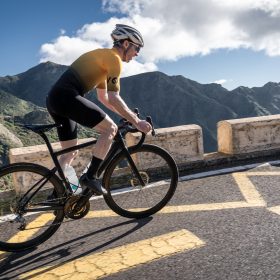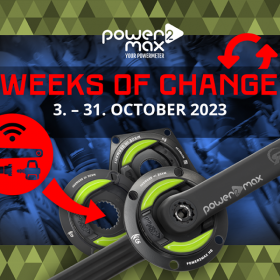Power output on the bike can depend on a variety of factors, but to check the accuracy of a powermeter, laboratory conditions are usually necessary. “Field tests”, e.g. comparison with other powermeters and indoor trainers, can only indicate that the accuracy must be tested on a test bench. The most suitable test here is still the “hill test”.
What should a powermeter do?
A powermeter is a sensor that should primarily display the same result under different conditions every time. The most important aspect is reproducibility. This means that if I pedal at 250 watts in snowfall after 5 hours of racing on a steep climb, the powermeter will also show me 250 watts (+/- the specified accuracy). In the same way, if I pedal at 250 watts on the flat on a sunny Sunday ride with friends just before the cake stop, the powermeter must also show me 250 watts. A power meter must therefore be able to provide reproducible results.
The accuracy of a power meter then comes in second place. This can also only be reliably tested against a so-called “test standard”. For this reason, we at power2max test each of our power meters with a certified torque sensor that has an accuracy of +/- 0.1%. With the help of this test, we can calibrate our power meters to the specified accuracy.
Factors influencing “perceived” power
Again and again, users of powermeters report that they have the feeling that a powermeter measures too little or too much. They compare the pedalled power with different powermeters on different bikes or with their heart rate.
Powermeters are used because heart rate is dependent on too many factors, such as sleep duration, temperature, cadence, riding position, daily form, excitement, when the last coffee was drunk, etc. As a result, heart rate as a comparative variable is unreliable. However, as a joint measurement with power output, heart rate can be a good indicator of training status and general health.
Different frame geometries and, as a result, different seating positions can lead to different perceived performance. From a biomechanical perspective, cadence also plays a role here. Some athletes feel comfortable at low cadence, others at high cadence. Still others have the feeling that 250 watts on a mountain with an MTB is much easier for them than 250 watts on the flat with a headwind on a road bike. A banal but sometimes not negligible factor can also be the tyre pressure, for example.
All these factors make an objective evaluation of the accuracy of a powermeter almost impossible. A test under reproducible conditions is necessary.
Comparison with other powermeters
A comparison with other powermeters is only partially reliable. In general, different powermeters should only be compared under exactly the same conditions. For example, a spider-based powermeter can be compared with a pedal-based powermeter during the same ride.
But here, too, there can be differences because the measuring point and measuring method are different. Only an objective test can make a statement about whether a powermeter is accurate.
How do I check the accuracy of my (power2max) powermeter?
The following steps apply to spider-based powermeters in particular. However, these points can also be used to test any other type of powermeter.
- Check your powermeter for damage.
Are there any deformations, cracks or corrosion? - Check that the crankset, chainrings and powermeter are firmly mounted with the specified torques.
- Tighten all bolts (lockring if necessary) after the first 2-3 rides.
- make sure that there is no connection between the chainring and the crank arm due to a chain pin that is too long or the shape of the crank arm. The chainrings must only touch the powermeter (or the adapter screwed directly to the powermeter). Also make sure that the powermeter does not touch the bottom bracket. This excludes a force shunt, which influences the deformation of the powermeter and thus also the accuracy.
- Perform a calibration three times in succession with the help of the power2max app or via cycle computer with ANT+. The displayed value should deviate by a maximum of +/- 3 points for NG and NGeco and +/- 8 points for older models (Classic and Type S). For cycle computers that only support BLE, please use our app.
- Perform a calibration on three trips before and after the trip and note the displayed values. Again, the deviation should not be greater than +/-3 or +/- 8 points.
- Do the hill test!
Checking the accuracy via the “hill test”
The aim of the hill test is to compare the average wattage displayed by your cycling computer on a precisely defined climb with the theoretical value. Here too, inaccuracies can occur due to imprecise input values and external factors (e.g. rolling resistance, friction losses, wind, etc.).
The prerequisites
Find the longest, steepest and smoothest hill or mountain in your area that you can climb three times in a row at constant power. It is important to ensure that the climb is as even as possible and does not contain any short descents. It is also an advantage if there is no wind or if the climb is sheltered from the wind.
Determine your exact system weight with your complete equipment (clothing, shoes, glasses, helmet etc.) and your bike (possibly with water bottles, spare inner tube etc.).
Set a precise start and finish point where you log a ‘lap’ on your cycling computer.
The execution
Ride the climb three times, making sure to be as constant and steady as possible. Make sure that the external conditions do not change. This also applies to water bottles, for example. If you start the first climb with two full water bottles, but take them off on the second attempt, the total weight can change by more than 1kg.
Note down the following values:
Total weight (rider + bike)
Altitude of the climb
Length of the climb (distance ridden between start and finish)
Time in minutes and seconds (mm:ss) you took to complete the climb.
The evaluation
If the external conditions are constant, you should see almost identical average wattage values for the climb if the time is exactly the same. Any difference should be within the specifications of your powermeter.
In addition, you can also compare your average wattage with the theoretical value that you can calculate by taking into account the collected values.
You can enter your values here (weight of rider, weight of bike, length of climb, metres in altitude and time). As settings for the tyres, we recommend “Regular” for the road bike. The seating position should be “Relaxed” or “Upright”.
The calculator then calculates your theoretical average power in watts, which you can compare with the average values displayed on your cycling computer. Due to inaccurate input values and other factors (e.g. wind and rolling resistance) there may be slightly larger deviations. However, these should not deviate by more than 10 watts from the specification of the powermeter.
Alternatively, you can also use Wolfgang Menn’s calculator .




